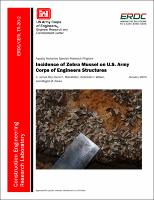Please use this identifier to cite or link to this item:
https://hdl.handle.net/11681/35273Full metadata record
| DC Field | Value | Language |
|---|---|---|
| dc.contributor.author | Hay, K. James | - |
| dc.contributor.author | MacAllister, Irene E. | - |
| dc.contributor.author | Wilson, Rebekah C. | - |
| dc.contributor.author | Brake, Abigail M. | - |
| dc.date.accessioned | 2020-01-24T14:25:12Z | - |
| dc.date.available | 2020-01-24T14:25:12Z | - |
| dc.date.issued | 2020-01 | - |
| dc.identifier.govdoc | ERDC/CERL TR-20-2 | - |
| dc.identifier.uri | https://hdl.handle.net/11681/35273 | - |
| dc.identifier.uri | http://dx.doi.org/10.21079/11681/35273 | - |
| dc.description | Technical Report | - |
| dc.description.abstract | Zebra mussels (Dreissena polymorpha) are invasive/nuisance species first introduced into the Great Lakes region in the late 1980s. Since their introduction efforts have been underway to prevent and/or control their spread. Zebra mussel infestations can occur on submerged critical structure. For the U.S. Army Corps of Engineers (USACE) it is essential that hydraulic infrastructure are effectively and efficiently maintained to ensure proper water control and navigation. A study was conducted to determine the extent of the zebra mussel invasion on USACE districts and the impact zebra mussels have on USACE infrastructure. Consistent with available U.S. Geological Survey (USGS) data, it was found that zebra mussels are present within 24 of the 36 continental United States USACE district boundaries, although San Francisco and Galveston Districts have only isolated populations in non-USACE waters. Albuquerque and Omaha Districts appear to be the two districts most at risk for invasion. While infestations are common, 62% of the districts with USACE infested waters reported no or minimal impacts on the infrastructure or operation/maintenance costs. Those districts with impacts did not normally have cost figures readily available. It was also found that 12 districts have or have had zebra mussel monitoring programs in place. | en_US |
| dc.description.sponsorship | Aquatic Nuisance Species Research Program (U.S.) | en_US |
| dc.description.tableofcontents | Abstract .......................................................................................................................................................... ii Figures and Tables ........................................................................................................................................ iv Preface ............................................................................................................................................................ vi 1 Introduction ............................................................................................................................................ 1 1.1 Background ..................................................................................................................... 1 1.2 Objectives ........................................................................................................................ 4 1.3 Approach ......................................................................................................................... 4 1.4 Scope ............................................................................................................................... 4 2 Methods .................................................................................................................................................. 5 2.1 Literature review ............................................................................................................. 5 2.2 Questionnaire .................................................................................................................. 5 3 Results .................................................................................................................................................... 6 3.1 Literature review ............................................................................................................. 6 3.2 Questionnaire results ................................................................................................... 11 3.2.1 Questionnaire responses .................................................................................................. 11 3.2.2 Mussel occurrence on Corps Infrastructure .................................................................... 11 3.2.3 Impacts of Mussels on Corps Infrastructure .................................................................... 13 4 Discussion ............................................................................................................................................18 4.1 Mussel occurrence on Corps infrastructure ................................................................ 18 4.2 Extent of mussel impacts at Corps Infrastructure ...................................................... 20 5 Conclusion ............................................................................................................................................ 26 Bibliography ................................................................................................................................................. 27 Acronyms and Abbreviations .................................................................................................................... 30 Appendix A: Questionnaire Responses................................................................................................... 31 Appendix B: Questionnaire Images ......................................................................................................... 61 Appendix C: Invasive Species Leadership Team Document ............................................................... 64 Report Documentation Page (SF 298) ................................................................................................... 68 | - |
| dc.format.extent | 76 pages / 5.163 Mb | - |
| dc.format.medium | PDF/A | - |
| dc.language.iso | en_US | en_US |
| dc.publisher | Construction Engineering Research Laboratory (U.S.) | en_US |
| dc.publisher | Engineer Research and Development Center (U.S.) | - |
| dc.relation.ispartofseries | Technical Report (Engineer Research and Development Center (U.S.)) ; no. ERDC/CERL TR-20-2 | - |
| dc.rights | Approved for Public Release; Distribution is Unlimited | - |
| dc.source | This Digital Resource was created in Microsoft Word and Adobe Acrobat | - |
| dc.subject | Zebra mussel | en_US |
| dc.subject | Introduced organisms | en_US |
| dc.subject | Nonindigenous aquatic pests | en_US |
| dc.subject | Hydraulic structures | en_US |
| dc.title | Incidence of zebra mussel on U.S. Army Corps of Engineers structures | en_US |
| dc.type | Report | en_US |
| Appears in Collections: | Technical Report | |
Files in This Item:
| File | Description | Size | Format | |
|---|---|---|---|---|
| ERDC-CERL TR-20-2.pdf | 5.29 MB | Adobe PDF |  View/Open |